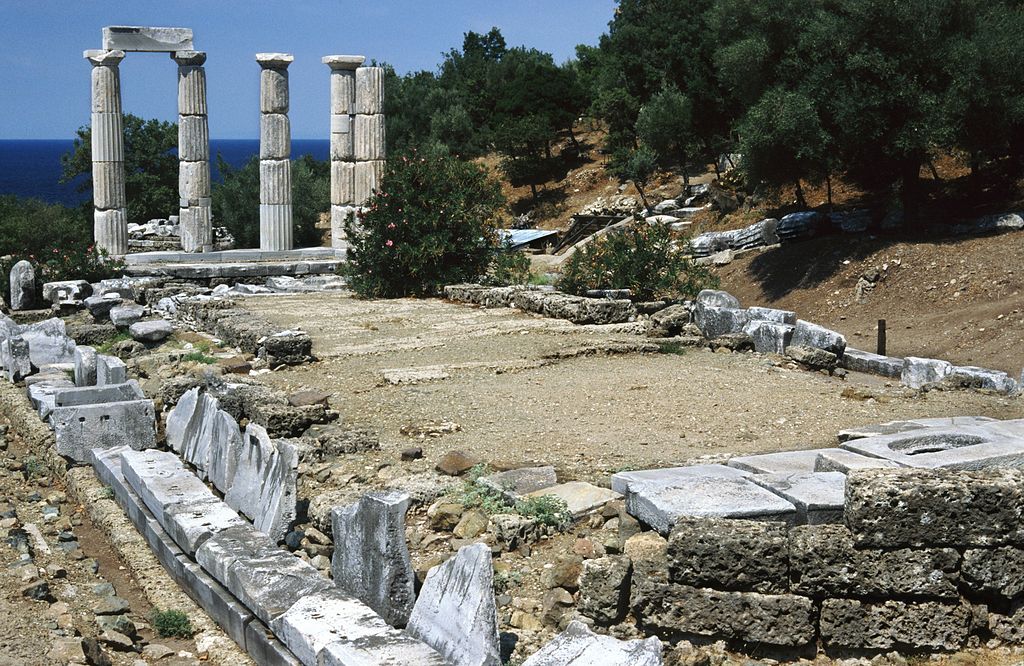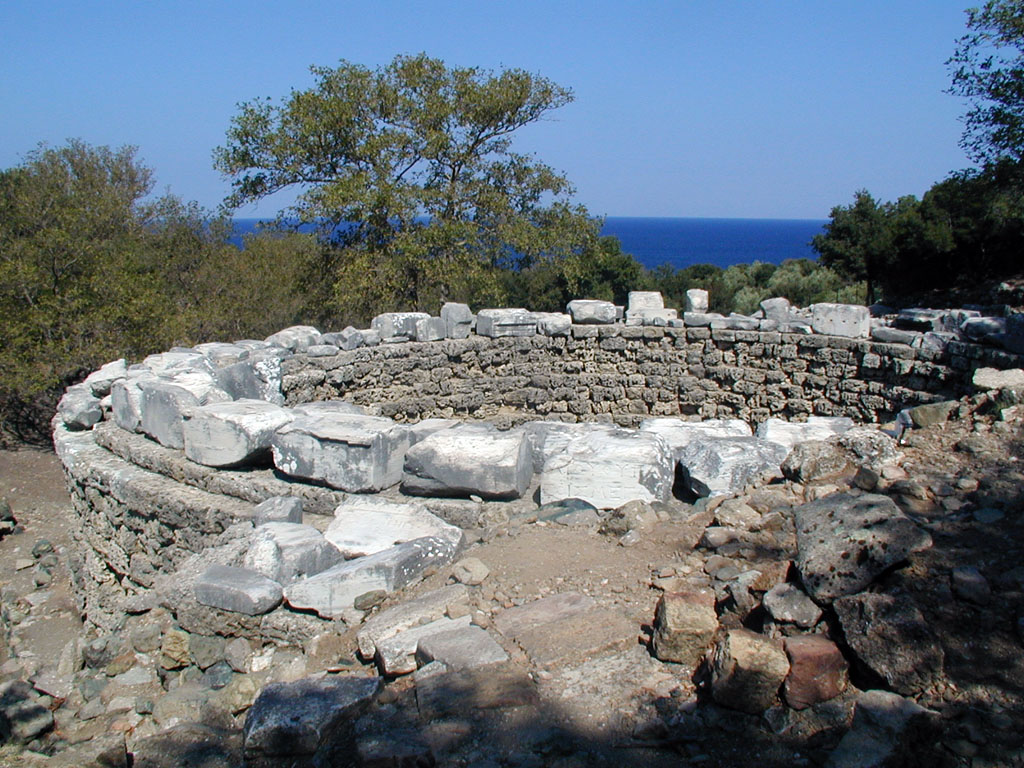
Samothrace, a small, rocky Greek island in the northern Aegean Sea, has a storied past that belies its diminutive size. One of the most rugged of all the Greek islands, its Mt. Saos rises to 1,611 meters (5,285 feet).
Known best for its Sanctuary of the Great Gods, or Hieron ton Megalon Theon, in Paleopolis, it was once the home of the stunningly beautiful 2.5-meter (8.2-foot) tall marble statue of Nike, created in 190 BC, now known as the “Winged Victory of Samothrace.”
Like so many other of Greece’s ancient treasures, it now is displayed in a European museum (in this case, the Louvre in Paris); but it was once part of the Sanctuary, whose remains still grace the island today.
Found in pieces in the ground by the French archaeologist Charles Champoiseau, the sculpture is recognized universally as one of the most arrestingly beautiful in all the world.
The ancient city on Samothrace, the ruins of which are called Palaeopolis (“old city”), was situated on the north coast of the island. Much of its ancient walls, which were built in massive Cyclopean style, are still extant.
Traditional accounts from antiquity state that the island of Samothrace was first inhabited by Pelasgians and Carians, and later Thracians. At the end of the 8th century BC the island is believed to have been colonized by Greeks from Samos, hence the name Samos of Thrace, which later became Samothrace.
The Samothrace Temple Complex served as one of the major pan-Hellenic religious sanctuaries; it was also a center for its own mystery religion which was open to the worship of all, not just a select few initiates.
The temple complex, which was visited by a panoply of notable figures from the past, including Lucius Calpurnius Piso Caesoninus, the father-in-law of Julius Caesar, was mentioned by Plato and Aristophanes.

The cult of the mysterious, unnamed “Great Gods” on Samothrace
During the Hellenistic period, after the investiture of Phillip II, it formed a Macedonian national sanctuary. It remained an important religious site throughout the Roman period with the Emperor Hadrian visiting Samothrace at one point during his reign.
Samothrace still has some of its ancient mysteries intact, and historians are still trying to discover the identity and nature of the deities venerated at the sanctuary. This is in large part because it was taboo to even pronounce their names in ancient times.
Literary sources from antiquity refer to them under the collective name of “Κάβειροι,” or Kábiroi) while they are also known by the simpler epithet of “Great Gods.”
The Pantheon of the Great Gods at Samothrace consists of numerous chthonic deities, meaning those having to do with the underworld. Incredibly, this even predated the arrival of Greek colonists on the island in the 7th century BC.

Earth Mother deity central in Samothrace
The Earth Mother, or Great Mother, a goddess often depicted on Samothracian coinage as a seated woman with a lion at her side, was the central deity at the sanctuary. Fortunately, her secret name, Axiéros, is known to us today. The Greeks associated her with the goddess of fertility, Demeter.
Hecate, under the name of Zerynthia, and Aphrodite-Zerynthia, two important nature goddesses, are equally venerated at Samothrace, although their cult was distanced from that of the Great Mother and more closely identified with deities more familiar to the Greeks, according to historians.
Kadmilos (Καδμίλος), the spouse of Axiéros, is a fertility god identified by the Greeks as Hermes. He was a phallic deity whose sacred symbols were a ram’s head and a baton (kerykeion), which can even be found on some currency.
Two other male deities accompany Kadmilos. These may be the two mythical heroes who are credited with founding the Samothracean mysteries: the brothers Dardanos (Δάρδανος) and Iasion (Ηετίων). They were associated by the Greek people of the time with the Dioscuri, the divine twins who were known as protectors of mariners in distress.
Mariners navigating around Samothrace left offerings to the gods
And that would be fitting, since ancient Greek mariners were known to leave offerings at the site of the sanctuary on Samothrace in order to secure their safe passage around the rocky island.
The sanctuary was open to everyone who wished to worship the Great Gods, unlike other sanctuaries in ancient Greece, which would only be open to certain initiates. The rituals and ceremonies at Samothrace were presided over by the priestess; its head priestess, who was often a prophetess, had the title of “Sybil,” or “Cybele.”
Prayers and supplications at the sanctuary would be accompanied by blood sacrifices of domestic animals, including sheep and pigs, whose carcasses were burned in sacred hearths, as well as libations made to the deities.
Many altars made of rock were used for these purposes, the largest of which was surrounded by a monumental enclosure at the end of the 4th century BC.
The major annual festival on Samothrace, which drew envoys to the island from throughout the Greek world, most likely took place in mid-July. Consisting of the presentation of a sacred play, which entailed a ritual wedding, this may have taken place in the building with the Dancer’s Wall, which was built in the 4th century BC.
Around the year 200 BC, a Dionysian competition was added to the festival, facilitated by the construction of a theater in the complex.
Many votive offerings were made at the sanctuary, which were placed in a building made for that purpose next to the great altar; typical offerings could have been statues of bronze, marble, or clay, as well as weapons or vases.
The first stage of the initiation rites into the Samothracian mysteries was the “myesis.” A sacred story and special symbols were revealed to the initiate. During the ceremony, he or she would receive a crimson sash tied around the waist which was meant to be a protective talisman.
An iron ring exposed to the divine power of magnetic stones on the island was most likely another symbol of protection conferred during the initiation, archeologists believe.
The sanctuary on Samothrace consists of three narrow terraces on the west slopes of Mount Hagios Georgios, separated by two steep-banked streams. The entrance is through the Ptolemy II propylaeum, also known as the Ptolemaion, which spans the eastern brook like a bridge.
A winding path then descends towards the main terrace, sited between the two brooks, where the main monuments of the sanctuary are found. A large tholos, the Arsinoëion, or Arsinoë Rotunda, is the largest covered round space in the ancient Greek world.
Measuring an incredible twenty meters (65 feet) in diameter, it may have served to welcome the theoroi, the sacred ambassadors sent by cities and associations to attend the great festivals at the sanctuary.

Building of the Dancers Frieze marks even more ancient sacrificial area
The Building of the Dancer’s Frieze, the largest at the Sanctuary, constructed on an even older sacrificial area, is located at the opening of the path leading to the site.
The most important building of the cult, the Epopteion, is located to the south of the Temenos. This building bears the inscription of Hieron. The interior boasts the largest unsupported span in the ancient Greek world at 11 meters (36 feet).
The Anaktoron, the building for greeting the religious initiates, is located north of the Arsinoë Rotunda.
The third and final terrace, west of the spiritual center of the sanctuary, is primarily occupied by buildings for offerings, such as the Miletean Building, dedicated by a citizen of Miletus, and the Neorion, or naval monument. It is also the location of what was once a banquet hall.
The space above all of these buildings is dominated by an enormous portico measuring an astounding 104 meters (341 feet) long; this acts as a monumental backdrop to the entire sanctuary.
The remains of a square Byzantine fort is also in this area; it was constructed of reused building material from the original site.
Strong ties to Macedonia, Philip II, and his wife, Olympias
The historian Plutarch, in his work Life of Alexander, says that Philip of Macedon, later to become the father of Alexander the Great, was initiated into the mysteries of Samothrace at the same time as Olympias. He immediately fell in love with her and betrothed himself to her at once.
The first sovereign of whom epigraphic traces remain was the son of Philip II and half-brother of Alexander, Philip III of Macedon, who would become the principal benefactor of the Sanctuary during the 4th century BC.
The second surge of major construction started in the 280’s BC with the building of the Arsinoe II Rotunda, which may date from 288–281 BC, when a daughter of Ptolemy I was married to the Diadochi Lysimachus, who was then king of Macedon.
Philip V of Macedon, the last Antigonid king to attempt to establish a Macedonian thalassocracy, or seaborne empire, had a monumental column dedicated to him in front to the large stoa of the upper terrace by the Macedonians by the year 200 BC.
Winged Victory statue created around 200 BC
Historians believe that it was probably during one of these episodes that the monumental fountain containing a ship’s prow of limestone and the masterpiece of the Winged Victory of Samothrace statue were created.
During the Roman, and particularly the imperial period, thanks to the interest of the Roman emperors, Samothrace became an international religious center, to which pilgrims flocked from all over the Roman world.
The island is mentioned in the Bible, with the name Samothracia; the Book of Acts records that the Apostle Paul on his second missionary journey sailed from Troas to Samothrace and spent one night there on his way to Macedonia.
The Ottoman Empire conquered the island in 1457. An insurrection against them by the local population during the Greek War of Independence (1821–1831) led to the wholesale massacre of 1,000 Samothracians.
Excavations of sanctuary continue down to present time
Following the 1863 discovery of the Winged Victory by French consul Charles Champoiseau, who was based out of Adrianople, the French team of Deville and Coquart carried out the first archeological excavation of Samothrace three years later in 1866.
Austrian archaeologists were next on the scene, uncovering the Ptolémaion and the stoa in 1873 and 1876; they also carried out several superficial excavations of the Hiéron and the Arsinoéion, as well as the Temenos.
As part of an agreement they signed with the Ottomans, the Austrians divided what is now considered the plunder of the site between Vienna’s Kunsthistorisch Museum, museums in Gallipoli and the Istanbul Archeological Museum.
As was often the case with Greek discoveries, some of the objects disappeared on the way to these institutions never to appear again publicly.
Champoiseau returned to Samothrace in 1891 to search for the blocks which formed the ship’s prow upon which the Winged Victory statue had been installed in Paris; while there, he discovered the theater that had been constructed in 200 BC as part of the Dionysian competition.
The Institute of Fine Arts of New York University started its first excavations in 1938, as a result of which the Anaktoron was unearthed. Interrupted by World War II, during which time the site suffered greatly as a result of Bulgarian occupation, they returned to Samothrace in 1948, and their excavations continue to the present day.